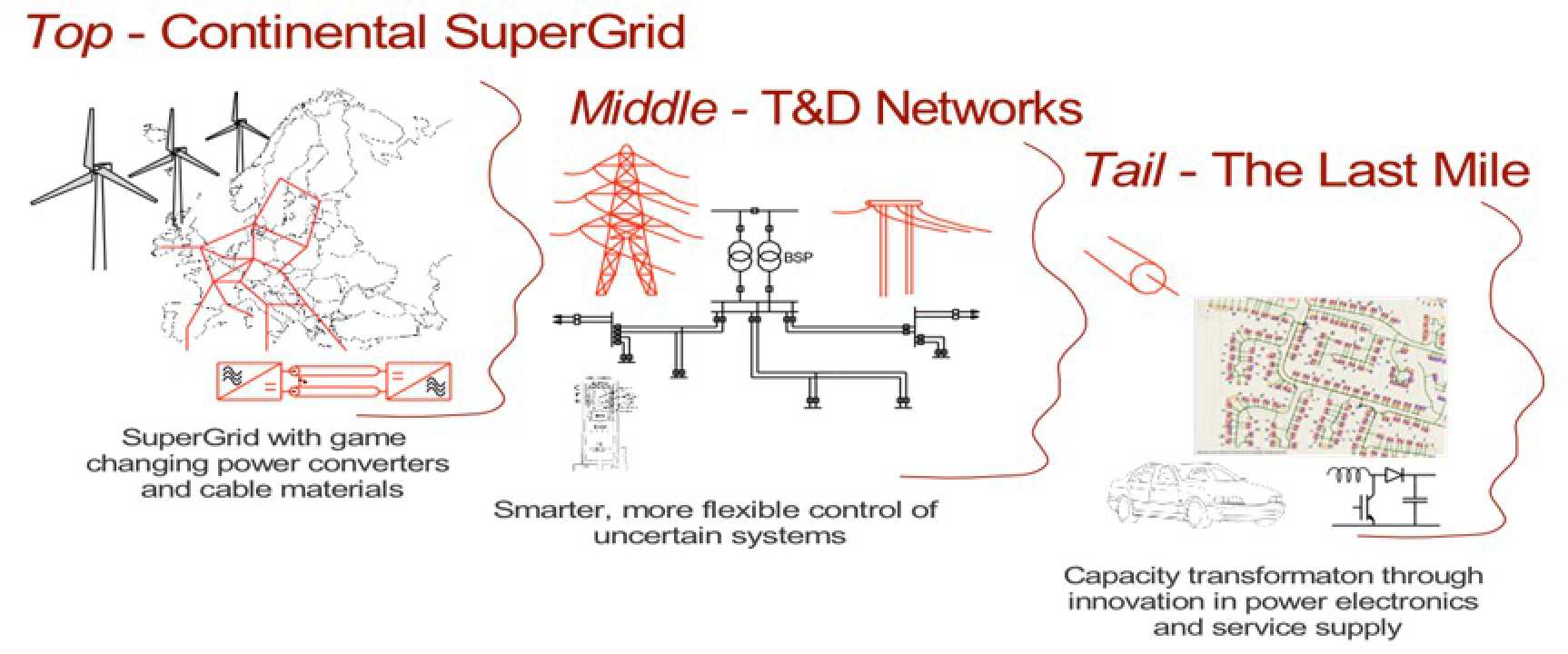EPSRC Transformation of the Top and Tail of Energy Networks
‘Transforming the Top and Tail’ is a collaborative and multi-disciplinary four-year project of eight universities funded by the EPSRC Grand Challenge Programme started in 2011. The project focuses on the physical infrastructure change in energy networks required to move the UK to a low carbon economy, and achieve the Government’s 2050 reduction in CO2 emissions target. The ‘top and tail’ are the 2 particular places in the energy network where existing technology and infrastructure need radical innovation as shown in the figure below.

At the ‘top’ of the network i.e. where the very highest transmission voltages occur, there is an expected emergence of transcontinental energy exchange in Europe, driven by exploitation of diversity in renewable sources and diversity in load. The challenge is to improve the current network technologies to facilitate the long distance bulk transfer of energy while simultaneously enabling the use of transmission for improving system security and balancing in the most economic manner.
The ‘tail’ of the network is the so-called last mile, and takes place behind the meter wiring into customer premises. More than half the capital cost of an electricity system is spent in the last mile, and cost and disruption barriers have made it resistant to change. The challenge is to re-engineer the way the last mile assets are used without changing the cables and pipes in the ground.
The Imperial’s work focuses on the following:
|
“Top” |
|
|
“Tail” |
|
Key publications:
- D. Pudjianto, M Castro, G Strbac, Z Liu, L van der Sluis, G Papaefthymiou, “Asymmetric Impacts of European Transmission Network Development towards 2050: Stakeholder Assessment based on IRENE-40 Scenarios”, Energy Economics, 2014.
- D. Pudjianto, M. Castro, G. Strbac, and E. Gaxiola, “Transmission Infrastructure Investment Requirements in the Future European Low-Carbon Electricity System”, Proc. 10th International Conference on European Energy Market Conference, Stockholm, 27-31 May 2013.
- C.E. Spallarossa, Y.Pipelzadeh, T.C. Green, “Assessment of Disturbance Propagation between AC Grids through VSC HVDC Links using Reduced Great Britain Model”, ACDC Conference, December 2012, Birmingham UK.
- C.E. Spallarossa, Y.Pipelzadeh, T.C. Green, “Influence of Frequency-Droop Supplementary Control on Disturbance Propagation through VSC HVDC Links” IEEE PES General Meeting, July 2013, Vancouver Canada.
- C .E. Spallarossa, C. Lin, X. Wu, T.C. Green, “A DC Voltage Control Strategy for MMC MTDC Grids incorporating Multiple Master Stations” IEEE Transmission and Distribution, April 2014, Chicago USA.
- Clemow, P.; Green, T.C.; Merlin, M.M.C., "Partial power operation of Multi-level Modular Converters under subsystem faults," Power and Energy Society General Meeting (PES), 2013 IEEE
Website: http://www.topandtail.org.uk/
Principal investigator: Professor Tim Green (t.green@imperial.ac.uk)
List of other CAP researchers
- Dr Phil Clemow (philip.clemow03@imperial.ac.uk)
- Thomas Frost (t.frost12@imperial.ac.uk)
- Giuseppe Laudani (g.laudani12@imperial.ac.uk)
- Dr Paul Mitcheson (paul.mitcheson@imperial.ac.uk)
- Dr Richard Silversides (r.silversides@imperial.ac.uk)
- Claudia Spallarosa (claudia.spallarossa10@imperial.ac.uk)
- Dr Danny Pudjianto (d.pudjianto@imperial.ac.uk)
External
- The list of universities partners involved in this project can be found at: http://www.topandtail.org.uk/uni_partners.html
- The list of the leadership team in this project can be found at: http://www.topandtail.org.uk/leadership.html


